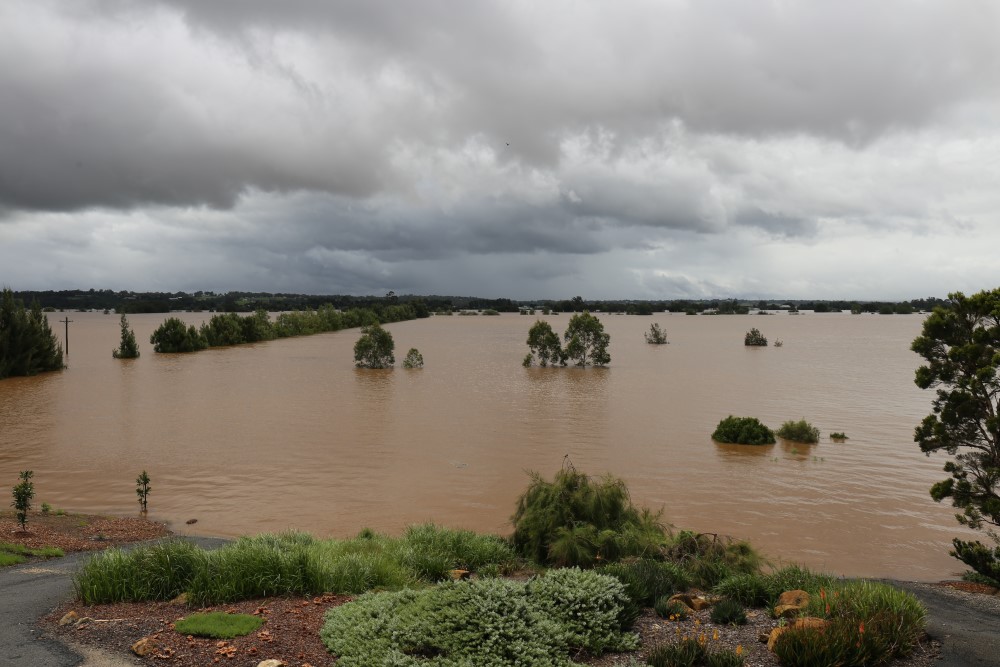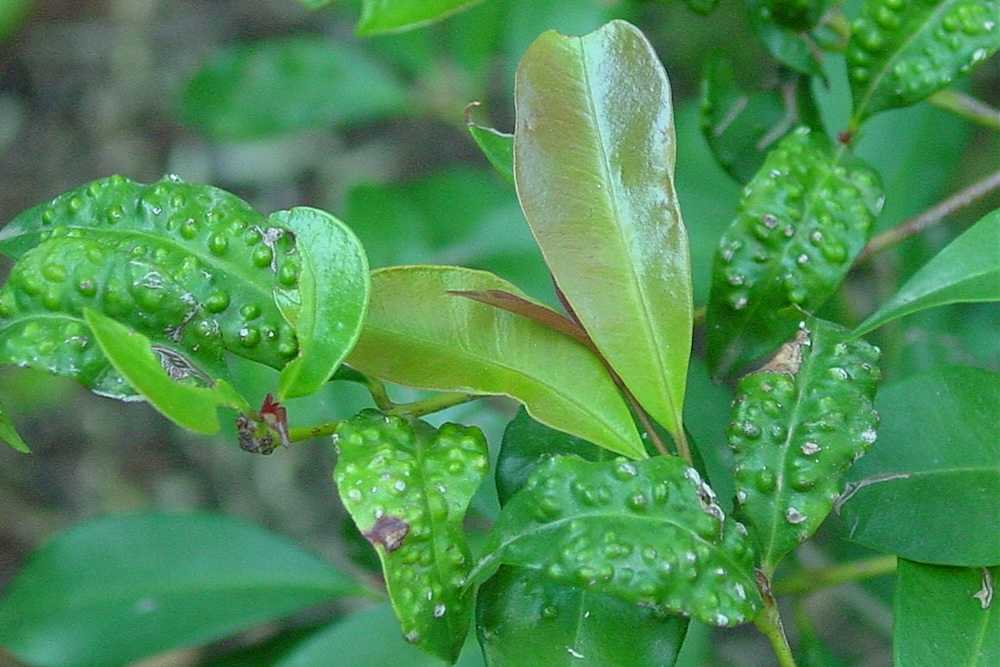In this article, we’ll delve into the world of aphids, scale and psyllids by understanding their life cycles, behaviours, and the harm they can inflict on lilly pilly plants.

Evaluation of Survivability of Different Landscape Plants in Various Wet Feet Conditions
Australian Study – Plants Surviving Extreme Wet Conditions
In a recent decade-long Australian study, researchers examined the impact of urbanization and altered land use on ecosystems, particularly related to weather extremes, plant waterlogging, and increased flooding.
The study aimed to identify plant species that can thrive in extreme wet conditions, providing landscape architects with opportunities to create more resilient landscapes in Australian developments.
These selected plant species act as buffers against wet conditions, enhancing the usability of the landscape.
Additionally, the study highlighted the success of certain drought-tolerant native plants during flooding events.
It also identified Lomandra and other species suitable for heavy wet soils, offering specific plant recommendations for Australian bio-retention swales and rain gardens.
Three testing procedures showcased extreme waterlogging over a 10-year period.
Area 1 evaluated plants’ ability to withstand wet feet conditions.
Area 2 examined their effectiveness in bio-retention swales.
Area 3 observed plant adaptability in floodplains. Analysing data from six recent floods, the study employed statistical tools such as two-way ANOVA and Pearson correlation coefficients to determine some factors influencing plant survival.
Testing Area 1
In Testing Area 1, which had heavy clay-type soil and extreme wet feet conditions, certain plant species showed impressive survival rates.
Evergreen Baby Lomandra and Shara Lomandra had a 100% survival rate. However, commercial types of Lomandra confertifolia and Lomandra longifolia performed poorly.
Liriope species thrived in the wet parts of Area 1. A root rot treatment trial revealed that treating Tanika Lomandra longifolia with Metcalf TdAVC1 & TdAVA2 and Rhizovital42 from OCP significantly improved survival rates.
Testing Area 2
In the Bio-retention swale Testing Area 2, Liriope and Rhaphiolepis Cosmic White, along with native plants like Slim, Better John, and Green John Callistemons, thrived for 10 years.
Wet feet loving Shara, Evergreen Baby, and Tropic Cascade Lomandra also thrived. However, many plants, including Dianella and Tristianopsis, did not survive the trial.
Testing Area 3
In Testing Area 3, the study examined plant survivability in floodplains. Overall, the study emphasized the importance of selecting resilient plant varieties for floodplain landscapes.
The number of floods experienced correlated with plant survival, and mature plants had a higher chance of survival compared to young plants.
Lomandra, Liriope, Dianella, Nandina, ornamental grasses, Agapanthus, turf grasses, and Callistemon viminalis generally survived well. Hibertia scandens, Murraya, Acacia and many other varieties showed varying results.
Study Findings
The study underscored the significance of breeding wet feet-loving plants and testing plants to survive extreme wet conditions, highlighting the importance of variety over species when selecting plants.
For example, Grey Box and Mundi Westringia thrived in the wet, while other Westringia varieties did not.
These findings offer crucial guidance for landscape planners working in urban environments with wet conditions.
They also provide nurseries with knowledge to recommend suitable plants for wet conditions.
Summary Table
See our recommended list of Waterlogging tolerant plants that also survive drought in the table below.
Trade Name and Variety, or botanical name |
Regularly waterlogged soils |
Bio-retention Swales |
Floods Extreme, Moderate, or Small |
| Agapanthus | Generally not | No | Extreme |
| Aloe | No | No | Minor |
| Purple Lea® Pennisetum alopecuroides ‘PA400’ PBR | Yes | Yes | Extreme |
| Nafray® Pennisetum alopecuroides | Yes | Yes | Extreme |
| Common | Yes | Yes | Extreme |
| Common | No | No | Moderate |
| Slim™Callistemon viminalis ‘CV01’ PBR | Yes | Yes | Extreme |
| Macarthur™ Callistemon viminalis ‘LC01’ PBR | Yes | Yes | Extreme |
| Red Alert™ Callistemon viminalis ‘KPS38’ PBR | Yes | Yes | Extreme |
| Better John™ Callistemon viminalis ‘LJ1’ PBR | Yes | Yes | Extreme |
| Green John™ Callistemon viminalis ‘LJ23’ PBR | Yes | Yes | Extreme |
| Camelia Various forms | Probably not | No | Extreme |
| Casuarina cunninghamiana | Yes | Probably | Yes |
| Casuarina glauca | Probably Not | No | Moderate |
| Cordyline australis | Probably Not | No | Moderate |
| Cupianopsis anacoides | Probably Not | Probably not | Moderate |
| Baeckea virgata breeding | No | No | Moderate |
| Breeze® Dianella caerulea ‘DCNC0’ PBR | Yes but spotted leaves | No | Extreme |
| Lucia™ Dianella caerulea ‘DC101’ PBR | Yes | No | Extreme |
| Fine Divine™ Dietes bicolor ‘Di2’ | Probably Not | No | Extreme |
| Blue Horizon™ Eremophila glabra prostrate ‘EREM1’ PBR | No | No | Moderate |
| Fraxinus griffithii New breed | Probably Not | No | Moderate |
| Yalba™ Imperata cylindrica | Yes | Yes | Moderate |
| Isabella® Liriope muscari ‘LIRF’ PBR | Yes | Yes | Extreme |
| Just Right® Liriope muscari ‘LIRJ’ PBR | Yes | Yes | Extreme |
| Katie Belles™ Lomandra hystrix ‘LHBYF’ PBR | Yes | Yes | Extreme |
| Lomandra longifolia ‘Katrinus Deluxe’ PBR | Mixed results | No | Extreme |
| Shara™ Blue Lomandra Fluviatilis LM380 | Yes | Yes | Extreme |
| Lucky Stripe™ Lomandra hystrix ‘LMV200’ PBR | Yes | Yes | Extreme |
| Nyalla®Lomandra longifolia ‘LM400’ | No | No | Extreme |
| Shara™ Lomandra fluviatilis ‘ABU7’ PBR | Yes | Yes | Extreme |
| Tanika® Lomandra longifolia ‘LM300’ PBR | No | No | Extreme |
| Tropic Cascade™ Lomandra hystrix ‘LHWP’ PBR | Yes | Yes | Extreme |
| Magnolia | No | No | Moderate |
| Melaleuca linariifolia | No | No | Moderate |
| Melaleuca Narrow form | No | No | Moderate |
| Yareena™ Myoporum parvifolium ‘PARV01’ PBR | No | No | Minor |
| Blush™ Nandina domestica ‘AKA’ PBR | Yes | No | Moderate |
| Flirt™ Nandina domestica ‘MURASAKI’ PBR | No | No | Moderate |
| Obsession™ Nandina domestica ‘SEIKA’ PBR | Yes | No | Moderate |
| Green Mist® Phormium | No | No | Minor |
| Plectranthus cillatis | No | No | Minor |
| Cosmic Pink™Rhaphiolepis indica ‘RAPH02’ PBR | Yes | Yes | Moderate |
| Cosmic White™ Rhaphiolepis indica ‘RAPH01’ PBR | Yes | Yes | Moderate |
| Grey Box™ Westringia fruticosa ‘WES04’ PBR | Yes | Yes | Extreme |
| Mundi™ Westringia fruticosa ‘WES05’ PBR | Yes | Yes | Extreme |
| Ozbreed Zen Grass® Zoysia spp. ‘ZOY01’ PBR Intended | Unknown | Unknown | Extreme |
| Nara Native Turf | Yes | Yes | Extreme |
| Empire Zoysia | Probably | Unkown | Extreme |
| Evergreen Baby™ Lomandra labill ‘LM600’ PBR | Yes | Yes | Extreme |
| Amethyst™ Liriope muscari ‘LIRTP’ PBR | Yes | Yes | Extreme |
Further Reading
For the full paper, click here, and for a full paper summary visit this page.








This Post Has 0 Comments